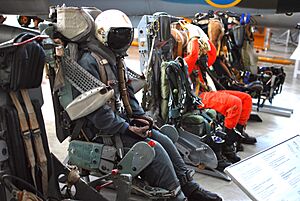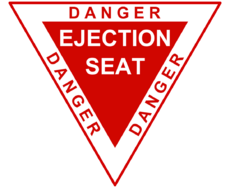Ejection seat facts for kids
An ejection seat is a special system in an aircraft, usually a military one, that helps the pilot or crew escape quickly in an emergency. Imagine the seat as a mini-rocket that shoots out of the plane, taking the pilot with it. Once the seat is clear of the aircraft, a parachute opens up to bring the pilot safely to the ground. This amazing invention is found in many military planes.
Contents
History of Ejection Seats
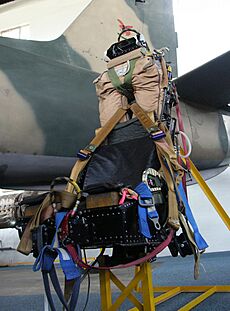
People have been thinking about ways to escape planes for a long time. In 1910, someone tried using a bungee cord to help them jump out! Later, in 1916, an inventor named Everard Calthrop patented an idea for an ejector seat that used compressed air.
The basic idea for modern ejection seats came from a Romanian inventor, Anastase Dragomir, in the late 1920s. He designed a "parachuted cell," which was like a chair that could be shot out of an aircraft. His idea was successfully tested in 1929 in France and Romania.
Ejection seats became really important during World War II. Before these seats, pilots had to jump out of a damaged plane, which was very hard. They might be injured, stuck in a small space, or pushed back by strong air forces.
The first real ejection seats were developed separately by companies in Germany (Heinkel) and Sweden (SAAB). The very first aircraft to have an ejection seat was a German jet fighter prototype, the Heinkel He 280, in 1940. On January 13, 1942, a test pilot named Helmut Schenk became the first person to use an ejection seat in an emergency. His plane's controls stopped working, so he ejected and landed safely! The first operational military plane to have ejection seats was the German Heinkel He 219 night fighter in 1942.
In Sweden, a gunpowder-powered ejection seat was tested in 1943 for the Saab 21 plane. The first time it was used in a real emergency was in 1946 after two planes crashed into each other.
Towards the end of World War II, another German jet, the Heinkel He 162 Spatz, used a new type of ejection seat powered by an explosive cartridge. This made the seat shoot up and out of the plane. Other planes, like the Dornier Do 335, also got ejection seats because their design made it hard for pilots to jump out safely.
After World War II, planes started flying much faster, even breaking the sound barrier. It became impossible for pilots to jump out manually at such high speeds. This made ejection seats even more vital. A British engineer, James Martin, and his company Martin-Baker played a huge role in making these seats better.
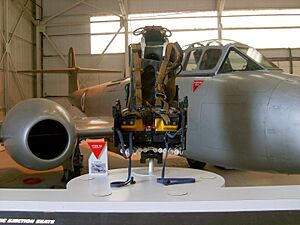
The first live test of the Martin-Baker system happened on July 24, 1946. A fitter named Bernard Lynch ejected from a Gloster Meteor jet. Soon after, on August 17, 1946, Larry Lambert became the first person to eject in the U.S. Martin-Baker seats were put into many planes starting in the late 1940s. The first emergency use of a Martin-Baker seat was in 1949 during a test of an experimental jet.
Early ejection seats used a small explosive charge to push the pilot out. But as planes got even faster, this wasn't enough to get the pilot far enough away from the aircraft. So, engineers started adding small rocket motors to the seats. In 1958, the Convair F-102 Delta Dagger was the first plane with a rocket-powered seat. Martin-Baker also developed a similar design. These rocket seats could even eject a pilot safely if the plane was very close to the ground.
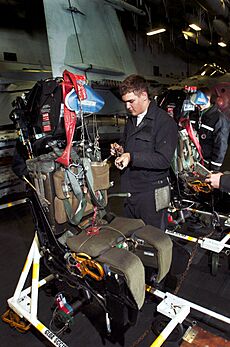
In the early 1960s, rocket-powered seats that could be used at supersonic speeds (faster than sound) were introduced in planes like the Convair F-106 Delta Dart. Some pilots have even ejected at incredibly high speeds. The highest altitude a Martin-Baker seat was used was 57,000 feet (about 17,400 meters) from a bomber in 1958. However, most ejections happen at lower speeds and altitudes, when the pilot realizes they can't control the plane anymore.
During the Vietnam War, the U.S. military looked into "flying" ejection seats. The idea was that after a pilot ejected, the seat would fly them to a safer area away from danger, where they could be rescued. This project was stopped after the war ended.
Pilot Safety During Ejection
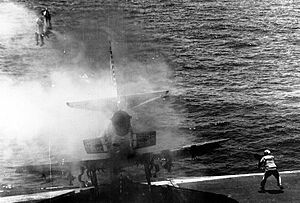
The main goal of an ejection seat is to save the pilot's life. When a pilot ejects, they feel a very strong push, like 12 to 14 times the force of gravity (12–14 g). Some older Soviet seats could even go up to 20–22 g. Sometimes, this strong force can cause injuries, like small fractures in the spine.
Scientists once thought that ejecting at supersonic speeds would be impossible to survive. But many tests, including some with chimpanzees, showed that it could be done.
A famous example of how well modern ejection seats work happened at an air show in 1993. The pilots of two Mikoyan MiG-29 fighter jets ejected safely after their planes crashed into each other in mid-air.
Modern seats, like the ACES II (used in many American jets) and the Russian K-36DM, are very advanced. The K-36DM seat, combined with special protective gear, allows pilots to eject safely at speeds from 0 to 1,400 km/h (about 870 mph) and altitudes from 0 to 25 kilometers (about 82,000 feet). This seat even has small shields that pop up to protect the pilot from the strong wind.
Believe it or not, pilots have even ejected successfully underwater a few times after their planes crashed into the ocean! The first recorded case was in 1954, when a British Royal Navy pilot ejected underwater and survived.
As of June 2011, Martin-Baker ejection seats alone have saved 7,402 lives across 93 air forces around the world. The company even has a special "Ejection Tie Club" for survivors, giving them a unique tie and pin!
Older ejection seats had a handle above the pilot's head. Pulling it not only ejected the pilot but also pulled a screen down to protect their face from the wind blast. Later, a handle was added in front of the seat, which was easier to reach, especially under high G-forces. Modern helmets also offer better protection, so the overhead handle is often no longer needed.
How Ejection Systems Work
Most ejection systems work in two steps. First, the aircraft's canopy (the clear cover over the cockpit) is either opened, shattered, or thrown off. Then, the seat and pilot are launched through that opening. In older planes, the pilot had to do these two steps separately. But in newer systems, like the ACES II, both actions happen with just one pull of a handle.
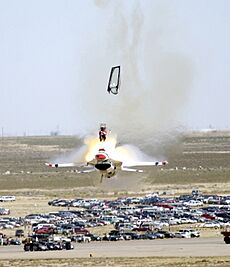
The ACES II ejection seat is common in many American fighter jets. In planes like the A-10 and F-15, there are two handles that do the same thing, so pulling either one works. The F-16 has only one handle between the pilot's knees because the cockpit is very narrow.
Some aircraft have different ways of ejecting:
- Downward Ejection: Some bomber planes, like the B-52 Stratofortress, have seats that eject downwards through hatches on the bottom of the aircraft. This is useful for crew members in lower positions. However, this system can't be used if the plane is flying very low to the ground.
- Through-Canopy Ejection: For planes that fly very low, waiting for the canopy to be thrown off can take too long. So, many aircraft, like the BAE Hawk and Harrier jump jet, use systems that shatter the canopy right before the seat launches. This is done with an explosive cord embedded in the canopy. Other systems use a sharp spike on top of the seat to break the canopy.
- Drag Extraction: This is a simpler system used in some experimental aircraft. It uses the airflow around the plane to pull the pilot out of the cockpit on a special rail. A small parachute then opens to pull the pilot away from the aircraft.
- Encapsulated Seats: For very fast bombers like the B-58 Hustler, special seats were designed that enclosed the pilot in a protective shell. This shell would keep the pilot safe from the extreme speeds and altitudes. These capsules could even float if they landed in water.
- Crew Capsules: Some aircraft, like the General Dynamics F-111, don't have individual ejection seats. Instead, the entire section of the plane where the crew sits can be ejected as one big capsule. Powerful rockets launch the capsule, and large parachutes bring it down safely. Airbags cushion the landing, and the capsule can float on water.
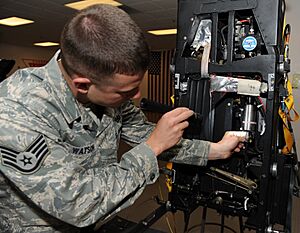
Zero-Zero Ejection Seats
A zero-zero ejection seat is a very important invention. It means the seat can safely eject a pilot even if the aircraft is on the ground and not moving (zero altitude and zero airspeed). This is crucial for emergencies during takeoff, landing, or even when the plane is just sitting on the runway.
Older ejection seats needed a certain amount of speed and height for the parachute to open properly. But zero-zero seats use small rockets to push the seat high enough into the air, and a small explosive charge to open the parachute canopy very quickly. This way, the pilot can escape safely even from a standstill on the ground. These rocket-powered seats also put less stress on the pilot's body during ejection, which helps prevent injuries.
Ejection Seats in Other Vehicles
While ejection seats are mostly known for airplanes, they have been used in a few other types of vehicles:
- Helicopters: The Kamov Ka-50, a Russian helicopter, was the first production helicopter with an ejection seat. Before the seat fires, the helicopter's main rotor blades are blown off by explosives to clear the way.
- Commercial Jetliners: The Soviet Tupolev Tu-144, a supersonic passenger jet, had ejection seats in its prototype version, but only for the crew, not the passengers. Production models did not have them.
- Spacecraft: Early space vehicles like Vostok, Gemini, and the first flights of the Space Shuttle (specifically Columbia and Enterprise) had ejection seats for the crew. However, they were later removed as crew sizes increased.
- Lunar Landing Vehicles: The Lunar Landing Research Vehicle (LLRV) and Lunar Landing Training Vehicle (LLTV), used to train astronauts for moon landings, also had ejection seats. Neil Armstrong famously ejected from an LLRV in 1968.
- Fiction: You might have seen ejection seats in movies! A famous example is the Aston Martin DB5 car in the James Bond films, which had an ejecting passenger seat. In real life, land vehicles don't have ejection seats.
See also
- Attacks on parachutists
- Caterpillar Club
- Escape pod
- Launch escape system
- Ejection Tie Club


